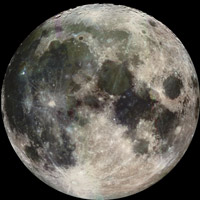The spacecraft was launched at 12:00 Israel time, and it will reach the moon on November 5. First pictures are expected at the end of November

China launched its first spacecraft to the moon on Wednesday, the first phase of an ambitious 1-year plan that will also see a robotic lunar rover return soil samples to Earth. Chinese television showed its photos of the launch of the lunar probe Shanzhe-XNUMX from the Shixedang Space Launch Center in the Sichuan province of southwest China.
On September 13, Japan launched A big hyphen to the moon In a move that is considered a leap forward in the unofficial space race among Asian countries. India is set to join the race soon when it goes ahead with its plan to launch its lunar rover in April. For several months there was a secret competition between China and Japan who would launch their satellite first, but in the end it was Japan who won the mini-race.
The Long March 3a launcher carrying the mirror spacecraft shortly after 10:12 p.m. local time (XNUMX:XNUMX GMT, XNUMX:XNUMX Israel time) after Chinese space agency officials confirmed that the weather conditions were good for the launch.
The Chinese evacuated several thousand people who live within 2.5 kilometers of the launch site were evacuated from their homes about two hours before the launch, according to the official Chinese news agency Xinhua. About two thousand tourists watched the launch for an entrance fee worth 800 yuan (about 106 dollars).
The Shenzhe-1 spacecraft is named after a Chinese goddess who flew to the moon. The spacecraft will orbit the Earth for a few days for the purpose of testing its instruments and then its engines will be ignited and adjustment will be made with the lunar orbit. The spacecraft will enter lunar orbit on November 5. The purpose of the project is to analyze the chemical and mineral composition of the surface of the moon. The spacecraft will also use stereoscopic cameras and X-ray sensors to perform 2,300D mapping of the surface. The spacecraft weighing XNUMX kilograms is expected to transmit the first images from the moon at the end of November, and continue to circle and explore the moon for about a year.
ShenZhen-1 is based on the Dongfanghong 3 communications satellite platform and will carry scientific equipment weighing 127 kg for a planned one-year mission. "In technical terms, Shenzhe-1 is actually a new spacecraft," wrote Lowen on one of the agency's websites. According to the site, Shenzhe-1 will carry a total of eight main instruments with which it will photograph and map the surface of the moon, explore the deep regions, analyze the chemical composition of the regolith as well as the space environment surrounding the moon. The budget of the operation is 1.4 billion yuan (about 180 million dollars).
CNSA officials previously said that Shenzhe-1 is planned to orbit the moon in a polar orbit at an altitude of 100-200 km. "Given the anomaly of the moon's gravitational field, ShenZha-1 may fall on the lunar surface within six months, if a 100 km high trajectory is chosen," Luan said, adding that if the mission managers decide not to explore the moon's gravitational field, The higher route will be selected. In order to reach the moon in the first stage, Shenzhe will be required to take off in an elliptical orbit whose closest point to the earth will be at an altitude of 600 km. After that, the mission managers will perform three maneuvers that will raise the spacecraft to a higher orbit and finally - to a transit orbit to the moon. "The transition to lunar orbit is the critical part of the Shenzhe mission," Luan said. "If this step is not performed correctly, the spacecraft will pass by the moon or hit it, two events with negative consequences.
The Dragon and the Space A two-part series about the Chinese space program

2 תגובות
I wonder what Japan's next step is? and of the competition